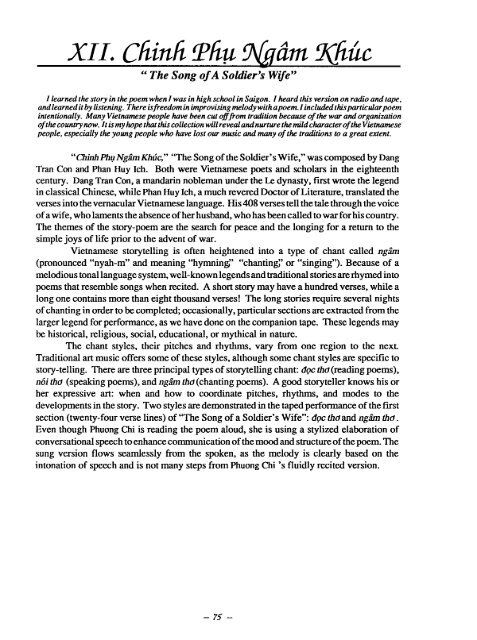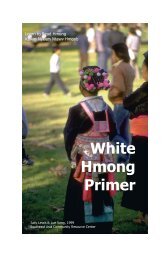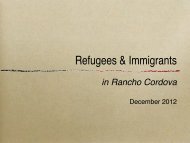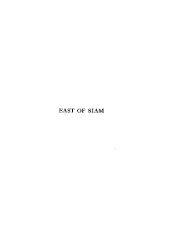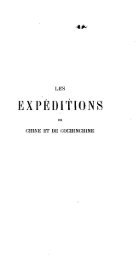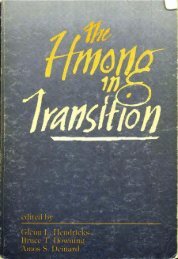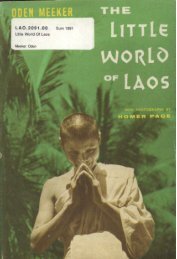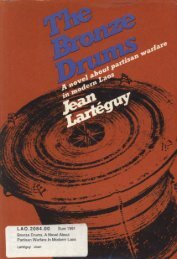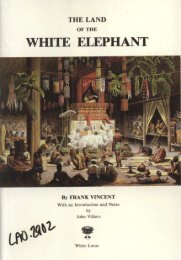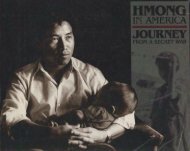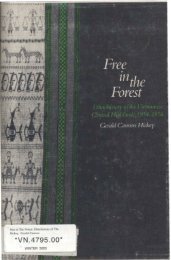and Temple Yards
iutnam From Rice Paddies and Temple Yards - Refugee Educators ...
iutnam From Rice Paddies and Temple Yards - Refugee Educators ...
- No tags were found...
Create successful ePaper yourself
Turn your PDF publications into a flip-book with our unique Google optimized e-Paper software.
" The Song of A Soldier's Wife"<br />
I learned the story in the poem when I was in high school in Saigon. I heard this version on radio <strong>and</strong> tape,<br />
<strong>and</strong> learned it by listening. There is freedom in improvising melody with apoem. I included this particular poem<br />
intentionally. Many Vietnamese people have been cut offrom tradition because of the war <strong>and</strong> organization<br />
of the country now. It is my hope that this collection will reveal <strong>and</strong> nurture the mild character of the Vietnamese<br />
people, especially the young people who have lost our music <strong>and</strong> many of the traditions to a great extent.<br />
"Chinh Phu N gh Khlic," "The Song of the Soldier's Wife," was composed by Dang<br />
Tran Con <strong>and</strong> Phan Huy Ich. Both were Vietnamese poets <strong>and</strong> scholars in the eighteenth<br />
century. Dang Tran Con, a m<strong>and</strong>arin nobleman under the Le dynasty, first wrote the legend<br />
in classical Chinese, while Phan Huy Ich, a much revered Doctor of Literature, translated the<br />
verses into the vernacular Vietnamese language. His 408 verses tell the tale through the voice<br />
of a wife, who laments the absence of her husb<strong>and</strong>, who has been called to war for his country.<br />
The themes of the story-poem are the search for peace <strong>and</strong> the longing for a return to the<br />
simple joys of life prior to the advent of war.<br />
Vietnamese storytelling is often heightened into a type of chant called ngh<br />
(pronounced "nyah-m" <strong>and</strong> meaning "hymning' "chanting:' or "singing"). Because of a<br />
melodious tonal language system, well-known legends <strong>and</strong> traditional stories are rhymed into<br />
poems that resemble songs when recited. A short story may have a hundred verses, while a<br />
long one contains more than eight thous<strong>and</strong> verses! The long stories require several nights<br />
of chanting in order to be completed; occasionally, particular sections are extracted from the<br />
larger legend for performance, as we have done on the companion tape. These legends may<br />
be historical, religious, social, educational, or mythical in nature.<br />
The chant styles, their pitches <strong>and</strong> rhythms, vary from one region to the next.<br />
Traditional art music offers some of these styles, although some chant styles .are specific to<br />
story-telling. There are three principal types of storytelling chant: doc thd(reading poems),<br />
nbi fbd (speaking poems), <strong>and</strong> n gh thd(chanting poems). A good storyteller knows his or<br />
her expressive art: when <strong>and</strong> how to coordinate pitches, rhythms, <strong>and</strong> modes to the<br />
developments in the story. Two styles are demonstrated in the taped performance of the first<br />
section (twenty-four verse lines) of "The Song of a Soldier's Wife": doc Ihd<strong>and</strong> n gh tho.<br />
Even though Phuong Chi is reading the poem aloud, she is using a stylized elaboration of<br />
conversational speech to enhance communication of the mood <strong>and</strong> structure of the poem. The<br />
sung version flows searnlessly from the spoken, as the melody is clearly based on the<br />
intonation of speech <strong>and</strong> is not many steps from Phuong Chi 's fluidly recited version.


